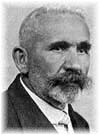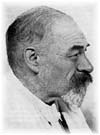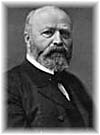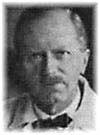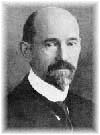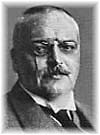Worldwide, neuropathology - as a branch of anatomic pathology - has virtually developed independently from its mother discipline. Strong influences regarding direction and contents of neuropathology came from
- the blossoming field of neurosurgery which developed in the second half of the 19th century, in particular through the collaboration of neurologists and the neurosurgeon Sir Victor Horsley, as well as through Harvey Cushing and Percival Bailey in the United States,
- psychiatry, which was - thanks to Emil Kraepelin - heavily based on neuropathological morphology, and the foundation of the German Research Institute for Psychiatry in Munich,
- progress in anatomic pathology which has always provided the field of neuropathology with some of its investigative methods
This kind of development was encountered - with regional differences as to its direction - in several European countries and the United States. In Germany, the main impact came from the German Research Institute for Psychiatry where the psychiatrists and neuropathologists Alois Alzheimer, Franz Nissl and Walther Spielmeyer were working. Many impulses and ideas in neuropathology but also in other neuroscientific fields originated from this "Munich School". A second line of development, which proved to be beneficial for neurology and neurosurgery, is associated with the names of Wilhelm Tönnis and Klaus Joachim Zülch. Both of these developmental lines were also called "neuropathology for the rough and for the intricate" (1). Furthermore, neuroanatomy - and in particular comparative neuroanatomy - played an important part in the development of neuropathology as a field (25).
The progress of neuropathology in the German-speaking world was further characterised by interaction with clinico-neurological disciplines. In an extensive review Jürgen Peiffer presented details of these often "mixed" schools (2). Anatomic pathology also held an important position, although less so than psychiatry and neurology. Detailing all the schools mentioned above would lead too far. However, two important developments should be documented briefly:
- The influence of the German Research Institute for Psychiatry which is maintained even to this day by the existance of the "Spielmeyer-School" and
- the successful endeavors in Germany of K.J. Zülch to establish neuropathology as a basic science of neurological diseases, intracranial masses and circulatory disturbances.
Thus, this presentation is affiliating the progress of neuropathology with individual names rather than schools, a method that has been advocated in most publications which exclusively (3) or peripherally (4, 5) dealt with this subject. It should not be forgotten that neuropathology as a basic science of clinico-neurological disciplines - in particular psychiatry - was also involved in the inhumane behaviour of physicians in the fields of race legislation and euthanasia during the Third Reich (6).
|
Neurohistology had its beginnings in the first half of the 19th century (9). The decisive point in the development of histological techniques regarding the nervous system was the tinctorial detection of the ganglion cell perikaryon by Franz Nissl who was a medical student at the time (10). Nissl had managed to depict the Nissl substance subsequently named after him, first with magenta red, later with other dyes, then kresyl-violet. Through this discovery Nissl came in closer contact to Bernhard von Gudden (11). Bernhard von Gudden (1824-1886), then Chair of Psychiatry in Munich, was physician to King Ludwig II of Bavaria and drowned with him at Pentecost 1886 in Lake Starnberg (12).
In Gudden’s brain-anatomical laboratory, into which Nissl was allowed, lay the seed for the future collaboration of psychiatry and neuropathology. Apart from Nissl, who created the basis for a relatively simple identification of the neuron in its orthology and pathology, his friend Alois Alzheimer is of paramount importance in the development of this discipline as well as for neuroscience in general. (13). With silver staining techniques, Alzheimer was able to detect pathological changes in the brain of a demented patient; these changes and the attempt to solve their pathogenesis and cause have remained important issues to this day and have initiated many exiting investigations.
Meanwhile, Walther Spielmeyer's work seemed to be most momentous (14). His "Histopathology of the Nervous System" (15) ought to be regarded as a compilation of the technical tools and equipment that created the basis for subsequent major findings and further advancements.
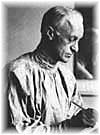 |
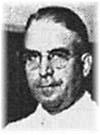 |
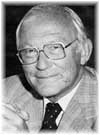 |
| Harvey Cushing |
Wilhelm Tönnis |
Klaus
Joachim Zülch |
In Germany and other countries, another part of neuropathology developed in close association with the foundation and progress in neurosurgery. Even though surgical procedures on the nervous system had been documented earlier (16), established in the second half of the 19th century Sir Victor Horsley is generally considered to be the founder of modern neurosurgery (17), which was based on earlier work by the neurologists Jackson, Gowers, Clarke. Closely affiliated with Horsley is Harvey Cushing who initiated a substantial incline of neurosurgery in the United States in the first half of the 20th century (18).
Cushing was known as a collector of katamneses; as a surgeon of brain tumours and in contrast to many - also present-day - neurosurgeons who saw the future of their discipline in more refined techniques, he was mainly interested in the fate and further clinical course of his patients. For this he needed the collaboration of a neuropathologist, and Harvey Cushing found Percival Bailey. This cooperation formed the basis of modern-day neurooncology (19).
In Germany, a similar constillation existed before, during and after the second world war: the collaboration of the neurosurgeon Wilhelm Tönnis with the neurologist and neuropathologist Klaus Joachim Zülch.
During his early years in Würzburg, later in Berlin and after the war in Cologne, Wilhelm Tönnis (1898-1978) consistently and very successfully worked toward an institutionalisation of neurosurgery in Germany. Ever since his time in Berlin, a close cooperation existed between the Kaiser Wilhelm-Institute for Brain Research and H. Spatz and K.J. Zülch (20). This collaboration resulted many publications on the classification of brain tumours (21), ), later with particular emphasis on their prognosis (22).
K.J. Zülch later became director of the Department of General Neurology of the Max-Planck-Institute for Brain Research in Cologne-Merheim and head of the Neurological Clinics in Cologne. There, he dedicated his work to important neurological topics, in particular circulatory disturbances and tumours of the nervous system. His work, always based on a neuropathological footing, still lives on. Thus, in spite of new genetically based aspects, the latest WHO classification of brain tumours (23) still carries the signature of Zülch’s empirically based and pragmatic views.
The German Society of Neuropathology was founded in Frankfurt/Main on 06.-08.10.1950. 37 men met at the inaugural assembly which was called "Association of German Neuropathologists". Driving force and president of this inaugural meeting was Willibald Scholz, neuropathologist at the German Research Institute in Munich at the time.
Up until 1956, the annual general assemblies were basically events with or without a limited number of topics and only few (up to 16) oral presentations. At the 6th meeting in Bonn in 1956, Gerd Peters - the only Chair of Neuropathology (in Bonn) at the time - and Hans Jacob, then in Hamburg, were reelected in their respective positions as president and secretary. Afterwards, the constitution of the society was decreed. In 1956, membership was also extended to include neuroanatomists. The society was then officially called "Society of German Neuropathologists and Neuroanatomists.". On 19 June 1956, the society was registered in Hamburg. The following annual meetings sometimes stood under a main topic which reflected the key scientific problem of the time. Particularly impressive were the joint meetings, be it with the Benelux countries, France and Poland, as well as the connections with neuropathologists from the former GDR.
In 1975 in Cologne, the name of the society was changed to "German Society of Neuropathology and Neuroanatomy".
After a long struggle, the consultancy for neuropathology ("Facharzt f6uuml;r Neuropathologie&qout;) was introduced in 1987.
In 1990, members of the "Society of Neuropathology" from the former GDR were incorporated into the German Society of Neuropathology and Neuroanatomy.
A summary of all the activities of the German Society of Neuropathology
and Neuroanatomy can be found at Strö,sser (thesis, up to 1992) (24).
German neuropathology has progressed and developed strongly since the end of the 19th century and the beginning of the 20th century, also benefitting from continuing exchange with other European countries and the United States. The Hitler regime and in particular the expulsion of Jews from our universities and scientific institutions constituted an enormous intellectual blood-letting that was followed by a difficult restoration phase after 1945. The tradition of the former Kaiser-Wilhelm Instiutes could partially be held up by means of the Max-Planck-Society where important places of employment were created for German neuropathologists.
The aim of the foundation of the society that today is called German Society of Neuropathology and Neuroanatomy had been to establish the discipline of neuropathology in German medicine, in particular in research, teaching and patient care within the universities. This has mostly been achieved; almost every university in Germany has a Department of Neuropathology at its disposal. However, neuropathological teams are rare in other major neurological and psychiatric clinics.Germany is the only country in the EU in which neuropathology is an officially recognised specialisation. At the same time and due to the rapid development of molecular biology - with particular emphasis on neurobiology - a new field for intensive research has opened up. Although small in personnel and with little political influence, neuropathology plays a leading role in research. These two facts, the establishment of the field of neuropathology in clinical medicine and its tasks in research, should justify cautious optimism for its further development and future.
